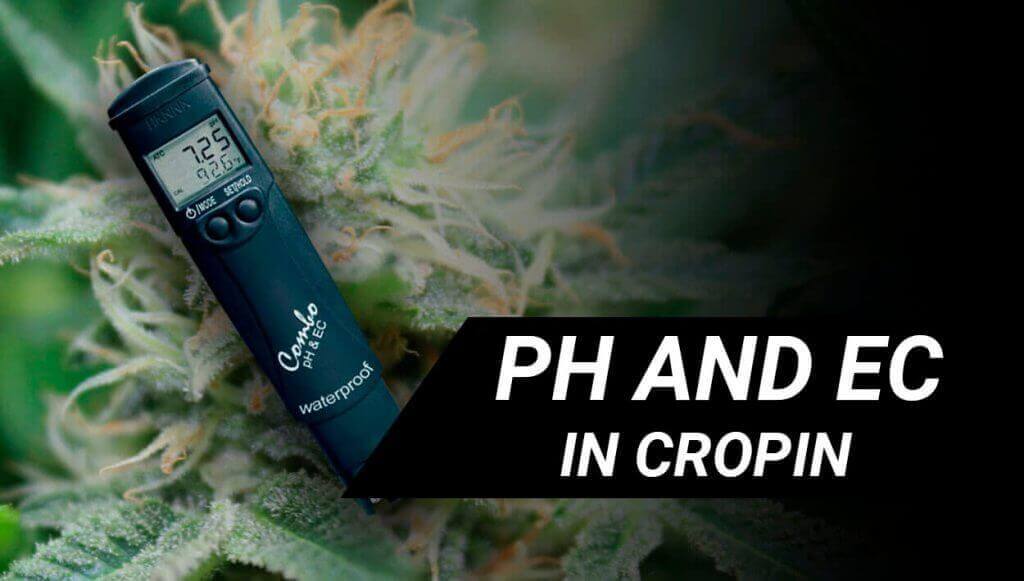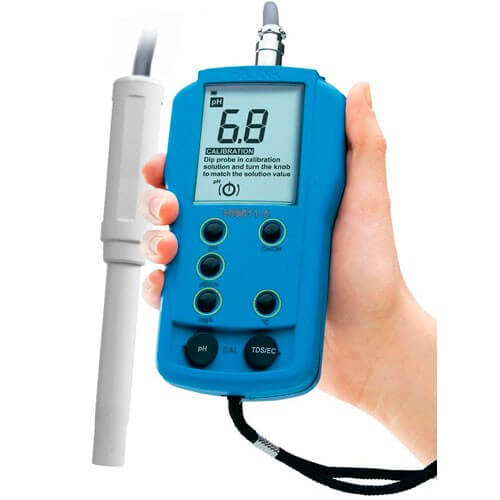Water/soil PH and EC need to be controlled in a crop.
Usually, growers focus on fertilizers and adequate doses, but not on PH and EC. They have to be controlled, because the nutrients need proper absorption, and we can control the food our plants are consuming.

ph and ec
If ignoring these parameters, the money for fertilizers would be wasted (useless effort).
What is pH (Potential of Hydrogen)?
PH, or Potential of Hydrogen, is an acidity measure or alkalinity of a substance, based on the amount of hydrogen ions – high concentration, acid; low concentration, alkaline. Irrigating water/soil PH has to be stable, so the plant will absorb the nutrients properly and it won’t block them.
PH moves 0-14, from top acidity to alkalinity. Every time pH alters in a complete point, alkalinity or acidity’s multiplied by ten. In fact, with PH 5 water/soil, its acidity would be ten times superior to PH 6, so, if water has 5 points, its acidity’s one hundred times superior to 7 water.
This way, a tenfold difference at every scale point has to be precisely controlled by the grower; otherwise, the plant wouldn’t absorb its necessary nutrients – the vital processes of the plant would get paralyzed: irrigating water/soil PH levels should be kept within pre-determined limits – the plant would properly absorb its nutrients, so they wouldn’t be blocked.
PH patterns
6.5-7 PH is ideal for cannabis to grow and properly absorb the nutrients. A lower pH will let the acid salts block the nutrients chemically, blocking its absorption from the roots. A higher range, that is, an alkaline range, won’t provide the necessary nutrients, and the accumulated toxic salts will become a problem.
Different systems
Different crops have different PH range. Hydroponic crop has a 5.8-6.8 range, slightly lower than in soil. In fact, in hydroponics, the nutrients are dissolved, and more useful than in soil, so PH solution can fluctuate half a point with no problem.
Irrigating water:
For soil crop:
- Growing stage: 6.0-6.5
- Flourishing stage: 6.5-6.8
Coir crop:
- Growing stage: 5.7-5.9
- Flourishing stage: 6.1-6.2
Soil PH: 6.0-6.6
General PH range is 4-8; below 4, the radicular plant system will get strongly harmed and, above 8, some fundamental nutrients won’t be absorbed, so we will have a weak plant.
Measuring patterns
Hydrogen potential can be measured with a simple PH electronic measurer, soil measurer or litmus paper. There are measuring kits for the general content of the nutrients when the soil is mixed with a chemical solution and compare the color with a reference table. The easiest way is an electronic measurer, cheap and easy to use.

Medidor pH+EC profesional
Effective pH control with an electrical measurer
- -Make sure the measurer probe is properly clean after usage, and remove corrosive tracks.
- -Compel the soil around the probe.
- -Make sure to irrigate the soil with distilled water, or provide neutral PH, before measuring.
EC (Electro-conductivity)
Electro-conductivity measures the amount of mineral salts in a substance. The salts perform EC, so abundant salts perform abundant conductivity. This measure shows us the amount of nutrients in irrigating water/soil, and it let us know if food’s abundant or scarce.
EC patterns depend on growing or flourishing weeks.
| Hanna | 1mS/cm = 500ppm |
| Eutech | 1mS/cm = 64ppm |
| new zealand hydro | 1mS/cm = 700ppm |
1mS/cm = 10fc or 0,7 EC = 7 FC
ppm-FC/EC conversion scale
| EC (mS/cm) | HANNA (0,5ppm) | EUTECH (0,64 ppm) | TRUNCHEONE (0,70 ppm) | CF (0) |
| 0,1 | 50 | 64 | 70 | 1 |
| 0,2 | 100 | 128 | 140 | 2 |
| 0,3 | 150 | 192 | 210 | 3 |
| 0,4 | 200 | 256 | 280 | 4 |
| 0,5 | 250 | 320 | 350 | 5 |
| 0,6 | 300 | 384 | 420 | 6 |
| 0,7 | 350 | 448 | 490 | 7 |
| 0,8 | 400 | 512 | 560 | 8 |
| 0,9 | 450 | 576 | 630 | 9 |
| 1 | 500 | 640 | 700 | 10 |
| 1,1 | 550 | 704 | 770 | 11 |
| 1,2 | 600 | 768 | 840 | 12 |
| 1,3 | 650 | 832 | 910 | 13 |
| 1,4 | 700 | 896 | 980 | 14 |
| 1,5 | 750 | 960 | 1050 | 15 |
| 1,6 | 800 | 1024 | 1120 | 16 |
| 1,7 | 850 | 1088 | 1190 | 17 |
| 1,8 | 900 | 1152 | 1260 | 18 |
| 1,9 | 950 | 1216 | 1330 | 19 |
| 2 | 1000 | 1280 | 1400 | 20 |
| 2,1 | 1050 | 1344 | 1470 | 21 |
| 2,2 | 1100 | 1408 | 1540 | 22 |
| 2,3 | 1150 | 1472 | 1610 | 23 |
| 2,4 | 1200 | 1536 | 1680 | 24 |
| 2,5 | 1250 | 1600 | 1750 | 25 |
| 2,6 | 1300 | 1664 | 1820 | 26 |
| 2,7 | 1350 | 1728 | 1890 | 27 |
| 2,8 | 1400 | 1792 | 1960 | 28 |
| 2,9 | 1450 | 1856 | 2030 | 29 |
| 3 | 1500 | 1920 | 2100 | 30 |
| 3,1 | 1550 | 1984 | 2170 | 31 |
| 3,2 | 1600 | 2048 | 2240 | 32 |
Currently, nutrient electricity can be measured differently: electric conductivity (EC), conductivity factor (FC), parts per million (PPM), total dissolved solid material (TSD) and, lastly, dissolved solid material (SD). They provide complex differences, although EC is more precise.
EC measuring
EC is measured in mili-siemens per centimeter (mS/cm) or micro-siemens per centimeter (uS/ CM). Since every nutrient and salt has a different electronic reading, it’s said that specific EC means specific quantity of nutrient solution, so ppm reading’s not precise.
Nutrient solutions used for cannabis crops oscillate 500-2,000 ppm. Generally, EC oscillates 800-1,200 ppm; otherwise, the plant will not be able to perform its basic vital functions.
Summing up, these patterns are extremely important for marijuana crops – you’d better take them into account; although many growers tend to ignore them, focusing on irrigation or plagues, they are totally necessary for an excellent product – no average stuff, just maximum quality and nice quality: for top results, you know, focus on these parameters.




